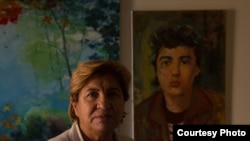It has been more than three decades since her child went missing but, deprived of answers, Mariam Saidi remains compelled to remember Maher through painting.
Mariam’s son was 15 years old and fighting for the Lebanese communist party during the country’s civil war when he disappeared in 1982.
“If someone is buried, you see him get buried — that's the picture that's in your head,” she said. “You don't change that anymore. But if someone is kidnapped, you start to imagine him in different shapes, in different ways. If someone is lost, you change the way he looks every hour.”
Mariam began using art to portray her son in the sleepless nights that followed his disappearance and have continued ever since.
Civil war
There are many others like her. Up to 17,000 people remain missing from the 15-year civil war that began in 1975. As the specter of conflict continues to haunt the country, the fight to remember is gathering urgency.
Of particular concern is that the aging of family members and the development of land by sometimes unscrupulous developers could make it impossible to gather information about the disappearance of people and the hidden mass graves scattered across Lebanon.
“The people who have the information [about the missing] are getting old, and the potential mass graves are being destroyed," said Justine Di Mayo, head of ACT for the Disappeared, a Beirut-based agency set up to help learn the fates of the missing. "It may be for a construction site or an archaeological site, but remains are being reburied under new buildings or even thrown into the sea.”
In response, efforts to push for the truth are growing.
Online memorial
ACT for the Disappeared is set to begin a nationwide dialogue that will seek to digitally restore the identities of those lost amid the violence of the civil war.
Volunteers, many recruited through universities, will set out across the country to talk to loved ones of the missing.
Training the volunteers has already begun, and it is hoped the interviewing process will begin within a few months.
But the questions will not focus on those so often associated with the long-term missing.
Instead of identifying the physical features that make them unique in death, interviewers will find out about the things that made the disappeared unique in life: their lives, their interests, their characters.
The information will then go to an online memorial that will double as a social media site, allowing access to images and words depicting the lives of the missing.
With the information made available to the public, the idea is that it will help the personalities and lives of those like Maher — a shy, talented boy with a love of music — emerge from behind the numbers.
“It is important for people to know who these missing people are,” Di Mayo said. “For the families, we must collectively recognize the lives of their loved ones and give them a place to tell their stories, because at the moment they have no official recognition; they don’t even have a grave.”
To gain public support
As well as providing comfort, the memorial aims to mobilize the public behind the cause and is one of a number of recently launched efforts by ACT.
Earlier this year, the group also started an investigation into the circumstantial evidence around those who went missing in some of the war’s most notorious incidents.
Despite their efforts, ACT faces an uphill struggle.
The ultimate aim is to pressure the state into legally protecting the suspected mass graves and then creating a commission to open these graves and investigate who is buried within them. However, overcoming bureaucratic inertia has proved difficult, especially when a number of senior politicians had their own role to play in the civil war.
Meanwhile, many are unwilling to confront the past. In a country still riven by political and religious divisions, there is concern that exploring the past may cause problems for the future.
But ACT is not alone in the push for the truth. Long before ACT’s launch in 2010, the International Committee of the Red Cross (ICRC) was working to identify the disappeared and engage with families.
DNA samples
It is now preparing to take saliva samples of family members in conjunction with Lebanon’s Internal Security Force with a view to DNA being collected to help identify remains found in mass graves.
The information is being gathered in anticipation of a formal commission being set up by the government.
Fabien Bourdier, who heads up the ICRC’s work on the missing in Lebanon, is optimistic.
Bourdier acknowledges that though much must still be done, the government’s decision in September to allow families of the missing access to a report into the matter, issued in 2000, is a positive sign.
“It’s been a forgotten issue in Lebanon and a taboo subject due to fears it might re-ignite the war, but we’re seeing a shift, and more people are willing to speak about it," he said. "We feel that closing this chapter off will help prevent the country from repeating itself.”
Syria conflict
Amid rising tensions exacerbated by spillover of the conflict in neighboring Syria, the dangers of sectarian division continue to loom large.
For Saidi, who learned just two years ago that her son might be buried in a suspected mass grave on the site of The Lebanese University, the wait continues, as does her fear that it could all happen again.
“The merchants of war are still alive,” she warned.
But in her loss, Mariam has also found companionship.
“We have mothers from the Lebanese Forces, from the communists; whoever has a lost son. We tell her to come walk with us, to join us, and we will search alongside her, whoever they are,” she said.











